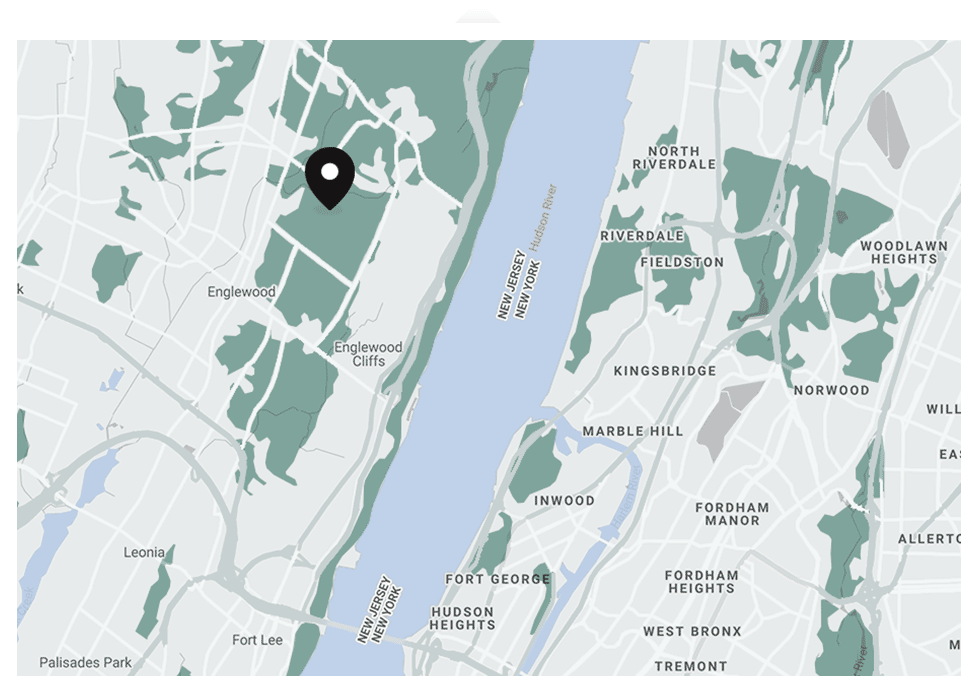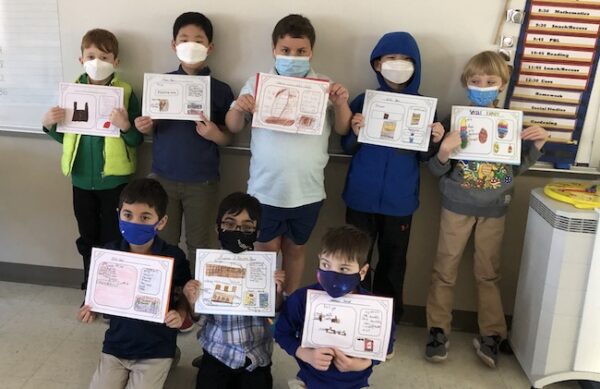Little School students answer real-world problems with the help of this problem-solving approach to teaching
Have you asked yourself questions like: How can you keep plastics out of the ocean?, How do animals adapt to their habitats?, How can humans safely explore a celestial object in our solar system?, or What would the world be like without spiders?, and then sought out the answers? That’s the basis of project-based learning (PBL): actively engaging in answering questions and solving problems.
This year, the Little School PBL team, including Director of Faculty Development Institute, Lower School STEAM chair, and Science Teacher Kara Makohon-Moore; Little School Librarian Cindy Cohrs-Brandt; Lower School Math Department Chair Mary Ann Rota, and Little School Art Teacher Sam Smithline took on this student-centered approach to teaching. They implemented the framework of PBL, creating developmentally appropriate and high-interest real-world problems for each grade level. Students investigated and researched topics, applied classroom content and critical thinking skills, performed the engineering design process that emphasizes open-ended problem solving and encourages students to learn from failure when needed, and transferred their 21st-century skill sets, such as collaboration, communication, and creativity, when answering real-world problems.
FIRST GRADE: WHY SHOULD WE SAVE THE MONARCH BUTTERFLY?
At the beginning of the school year, one of the topics driving the curriculum was why we should save the monarch butterfly. To better understand the recent decline in the butterfly population, students explored the butterfly and milkweed life cycle, pollination and seed dispersal and its importance for plants and animals, mapping of current monarch migration, and symmetry found within nature and how it applies to the monarch butterfly. Students conceptualized ways to help the monarch butterfly populations and presented their findings to the EMS gardening staff and maintenance crew.
ADDITIONAL QUESTIONS OUR FIRST-GRADERS STUDIED:
- How can we show others that shapes are all around us?
- What makes someone a community hero?
- What would you need to take with you into space?
- How do animals adapt to their habitats?
- How can I create a store and product for my community?
SECOND GRADE: HOW CAN WE CREATE A BEST-SELLING CHOCOLATE CANDY?
Did you know that a single chocolate chip gives an adult the energy to walk 150 feet? Did you know that Forrest Mars Sr. had a severe peanut allergy but still created peanut M&Ms because he believed they would become a best-selling chocolate candy? Our second-graders have learned these fun facts and more through completing their April PBL unit.
The driving question — How can we create a best-selling chocolate candy? — prompted students to research the history and geography of the cacao bean, learn the sequence “from bean to bar,” survey their classes for favorite chocolate candies, research different packaging ideas, and brainstorm different foods that go well with chocolate. Then, they used this knowledge to create their own “best-selling” chocolate and its packaging. While presenting their creations to our live audience, the second-grade chocolatiers talked about complementing flavors, gave nut-free alternatives, and shared the price of their chocolate. To continue learning at home, the students made Nestle Toll House chocolate chip cookies, produced choc- olate ice cream in a bag, and watched Charlie and the Chocolate Factory.
ADDITIONAL QUESTIONS OUR SECOND-GRADERS STUDIED:
- What would you need to do to survive in the wilderness?
- What would the world be like without spiders?
- Why are flags important to people?
- What masks do we wear when we go about our daily lives?
- How would you plan a road trip to your favorite state?
THIRD GRADE: HOW WOULD YOU CREATE THE MOST POPULAR TOY OF 2021?
In third grade, students explored toy designs, concepts, and their production process, aiming to create the most popular toy for 2021. They investigated the func- tion of toys and the evolution of materials that changed with industry trends. Students learned about the toy business by studying marketing techniques relating to toy packaging and toy displays, and by designing the inside of a virtual toy store. In their final presentations, the third-graders demonstrated ingenuity and innovation in their toy designs by building prototypes, drawing detailed sketches, or developing a writing piece to promote their unique idea.
ADDITIONAL QUESTIONS OUR THIRD-GRADERS STUDIED:
- What would the world be like without rocks and minerals?
- How can we keep our communities safe during natural disasters?
- How can we design a tiny house that meets the needs of a client’s new summer home?
- How can we keep plastics out of the ocean?
- How do I design a kite for the American Kitefliers Association competition?
FOURTH GRADE: HOW WOULD YOU HELP SOMEONE WITH A DISABILITY?
To learn how they could help someone with a disability, our fourth-graders participated in the Disability Awareness Fair, where they had an opportunity to experience what it is like to struggle with a disability. Students also enjoyed stories of individuals overcoming the challenges of disabilities, explored the Little School campus to identify challenges for individuals with disabilities, and conducted research on a disability of their choice. For their final projects, they created a variety of different products, including invention prototypes such as dyslexia glasses, prosthetic limbs, and hearing aid devices, as well as public awareness programs through speeches, posters, and movies, and T-shirt designs for a walkathon.
ADDITIONAL QUESTIONS OUR FOURTH-GRADERS STUDIED:
- How can you visit Morristown National Park safely?
- How can restaurants prepare to remain open safely in the winter during COVID-19?
- How can humans safely explore a celestial object in our solar system?
- How can I design a board game that my whole family will enjoy playing?
- How can I design a new theme park for friends and family that is engaging, interactive, and entertaining?
TEACHERS: WHAT WERE THE RESULTS?
In February, the first study ever recorded on project-based learning came out and the results provided a case as to why rigorous PBLs are needed in schools. In addition, four studies released by Lucas Education Research, along with researchers from five major universities, showed that PBL curriculums strengthen student engagement, improve learning and retention information, boost achievement across content areas, and reach all students from all types of backgrounds.
“From our own experience this year, the results referenced in these studies are similar to what we are seeing in our students,” says Cohrs-Brandt. “The excitement is infectious and these results show why we continue to do PBL.”
“We want to make sure that our projects are based on a foundation that is integrated with the best of teaching practices,” adds Smithline. “The approaches within the PBL units that we implement, like STEAM, 21st-century skills, the engineering design process, and core content skills are areas that work in tandem, rather than separately. It is important that children see that as well.”
“Children do not go and play with their friends and decide that they want to do science today; they are already curious explorers trying to understand their world around them. Children do this without even realizing they are doing the ‘science,’” says Makohon-Moore. “We need to capitalize on this thinking and their interest level and help them apply skills on how to think, become informed, and understand how all subject areas work together.”
This is what project-based learning truly is. This learning approach challenges educators to align their curricular standards, create integrated assessments, and develop lessons that challenge students to think and make their own opinions. This allows our teachers to make sure lessons are taught with integrity and that, most importantly, students are able to transfer their learning and understanding of new knowledge to different aspects of the curriculum.
– Kara Makohon-Moore, Cindy Cohrs-Brandt, Mary Ann Rota, and Sam Smithline
There's No Better Time to Support Your Child's Education
Every time you donate to one of Elisabeth Morrow's dedicated funds, you help enrich the daily experiences of our community on campus. STEAM spaces are improved, library catalogues expanded, scholarships are funded, and teachers are hired. Every day, you can see the impact your generous donations have on campus.


